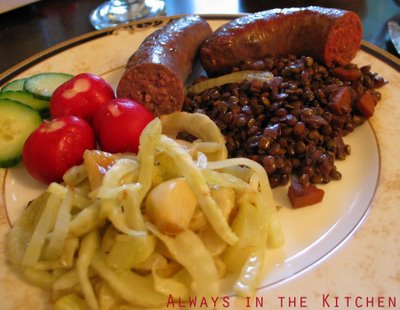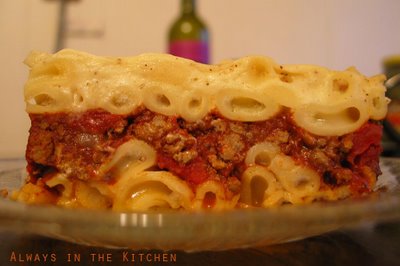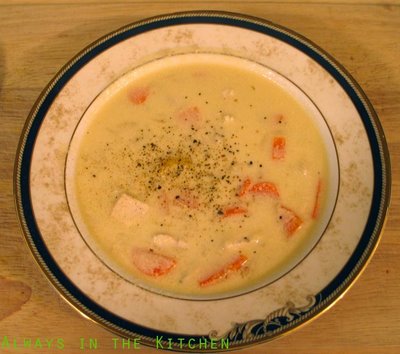 Last weekend, in the narrow slot of time between finishing my old job and starting the new one, I went to see friends on Vancouver Island. The plan was to do a little tour of the growing number of wineries there, and have lunch at one of them. Since we were scheduling around the transportation challenges of not only our arrival from the mainland, but also our friends' seven month-old baby, it took a while before we were on the road. We failed in our mission to complete an actual tour, per se, but we succeeded in having an absolutely delicious and revivifying lunch on the deck of Vinoteca Resaurant, overlooking (and a part of) Zanatta Winery's vineyards.
Last weekend, in the narrow slot of time between finishing my old job and starting the new one, I went to see friends on Vancouver Island. The plan was to do a little tour of the growing number of wineries there, and have lunch at one of them. Since we were scheduling around the transportation challenges of not only our arrival from the mainland, but also our friends' seven month-old baby, it took a while before we were on the road. We failed in our mission to complete an actual tour, per se, but we succeeded in having an absolutely delicious and revivifying lunch on the deck of Vinoteca Resaurant, overlooking (and a part of) Zanatta Winery's vineyards.After a quick tour of their wine varietals in the tasting room, we sashayed out to the lovely wrap-around verandah and gazed down the vineyards while waiting for our food. We had a bottle of one of their sparkling wines, the Fatima Brut, which boasted toasty flavours (our favourite, in a champagne-style wine!) and tucked into the elegant but simple Italian fare on offer from the kitchen.
 My salad had crispy pancetta, strips of citrus zest, melon balls, feta, on a bed of assorted bitter greens. The dressing was fig and balsamic vinegar. There was a sweet and sharp and salty combination that worked perfectly as an appetizer, revving up my tastebuds for the main dish. I'm not one to order salads, usually, but this just sounded so refreshing that I couldn't say no. It was an excellent match to the sparkling wine, and the sunny-but-cool weather.
My salad had crispy pancetta, strips of citrus zest, melon balls, feta, on a bed of assorted bitter greens. The dressing was fig and balsamic vinegar. There was a sweet and sharp and salty combination that worked perfectly as an appetizer, revving up my tastebuds for the main dish. I'm not one to order salads, usually, but this just sounded so refreshing that I couldn't say no. It was an excellent match to the sparkling wine, and the sunny-but-cool weather. Moving along, my pasta was also delightful - with darker, more earthy flavours compared to the brightness of the salad. There was a mushroom broth, little strips of proscuitto, and black olives, with shredded sage. The pasta was almost defiantly al dente, and the last few pieces of pasta had soaked up the rich juices beautifully.
Moving along, my pasta was also delightful - with darker, more earthy flavours compared to the brightness of the salad. There was a mushroom broth, little strips of proscuitto, and black olives, with shredded sage. The pasta was almost defiantly al dente, and the last few pieces of pasta had soaked up the rich juices beautifully. The two men both opted for the polenta cake with chorizo and red pepper sauce, served over mustard greens with a mighty shard of parmesan cheese. It looked good, and the little bite I got of chorizo was very agreeable, but I didn't try much of it, with a rather large lunch of my own to work at.
The two men both opted for the polenta cake with chorizo and red pepper sauce, served over mustard greens with a mighty shard of parmesan cheese. It looked good, and the little bite I got of chorizo was very agreeable, but I didn't try much of it, with a rather large lunch of my own to work at.I was too full for dessert, although my companions had some. The custard and fig cake looked so outstanding that I had to steal a tiny bite, even though I was quite full. I wish that I had remembered to take a picture of it.
We were leisurely enough at our lunch (and I would not have rushed, anyway) that we only had time to make one more place to visit before it was time to head back to the house. We went to the Merridale Cidery, and had a walking tour of the cider mill before taking to the tasting room. After a look at the menu for their restaurant La Pommeraie, we immediately swore (despite our full stomachs) that we would be back to try it soon. We sampled quite a few different ciders, and picked up a Traditional Cider and a Winter Apple - sort of the icewine of ciders, sweet, rich, and heavy, and perfect for after dinner.
We didn't make it to Blue Grouse, or any of the other places on our list, but that can mean only one thing: another attempt at an Island wine tour is definitely required. Preferably, soon.














